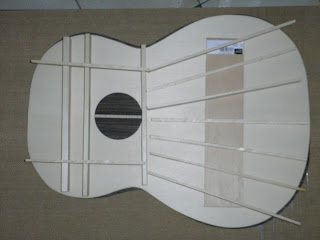Here are the details:
Session 1
I bought some tools from Daiso at $2 each.
It is really a good place to get cheap and good tools.
(They do sell alot of other good stuff but that's another story...)
- F-clamps
- Chisels
- Scrap woods (bass wood)
I started the guitar making process by sawing the struts from the block of spruce.
Using coping saw to saw the spruce block is not an easy task; it is very easy to deviate from straight line.
So to cope with that, I deliberately increase the thickness of the marking for at least another 50% or so.
(It is bound to happen actually, so got to think of ways to recover from the mistake.)
This is to leave enough margin for mistakes.
E.g. I need 6 mm thickness I would marked the line at 1.5 cm or so.
The difference would be removed by planing.
At the end of the session I have sawn quite number of struts, but still a long way to go...
One of the important points to take note is that, after sawing the brace, ensure that the surface is flattened by planing it.
This has to be done before you start to saw the next brace from the spruce block.
If this is not done properly, you could end up with a crooked struts.
Unfortuately, some of the struts which I have sawn, exhibit this mistake...
Session 2
In order to alleviate some of the hand and back pains I experience while sawing the struts, I bought a electric Jig Saw.
I bought it at AMK NTUC Extra which cost about SGD40.
Unfortunately after trying to use it for sawing the struts, the result was not what I had expected and very unsatisfactory.
If you think using the coping saw was hard, using Jig Saw was even harder,
especially in controlling it to saw in a straight line.
As a result, regretably, I wasted quite a bit of the spruce block :(
(Luckily I ordered 2 more spruce block, knowing that I would make stupid mistake here and there.)
According to my more experienced friend EJ, who has dabbled quite a fair bit in this art of luthiery, in order to make the Jig Saw cut in a straight line properly, you need a fence guide.
I was thinking of making a mold or something to achieve that.
One of the way is to fix the Jig Saw on a mounting block and use it like a Band Saw.
If that is the case, the the fence guide would simply be another removeable plank hold in place using the F-clamps.
However, making the mount could take some time and effort and my little work bench wouldn't have enough space to hold the mount either.
You need a proper size workbench instead.
Session 3
I have just bought a new digital camera (Ricoh R6) to take some pictures of the guitar making process.
All the pictures shown was actually taken during this session.
I merely backdate it.
I bought some more new tools from Daiso:
- Japanese carpenter saw
- Mallet (for hammering in the frets)
- Clips for clipping the kerfing
- Some screws and nuts (for making the mounts)
- Cork sheets for protecting the wood surface during clamping.
I also bought some tools at Art Friend:
- Adjustable carpenter square (for ensuring perfect straight and perpendicular edges)
- 1 metre rule (for measuring the string course length 650 mm)
- Some more bass wood for scraps
Here is a picture of my mini work bench and tools.
Top to bottom:
- Coping saw
- Adjustable Carpenter Square
- Japanese Carpenter saw
- Plane
- F-clamp

Sawing the brace:

Planing the block before sawing the next brace (Note the F-Clamp at the end to faciliate planing)

After sawing all the braces for the tops, I laid them out on the spruce top board.
Finally I can see the light after labouring for so long...

Here's another view

Bracing design
Explanation about the struts
The topboard is the most important part of the guitar
To support the string tension the topboard would have to be very thick.
However a thick top would not make a good sound and probably hardly any volume at all.
So in order to support a thin top (typically 2-3mm thick), struts of bracing have to be added to the top board to support the pull of the string.
The struts are laid in a pattern known as the fan struts; they fan out towards the lower part of the guitar.
It was developed by the Spanish Luthier Antonio de Torres.
Newer patterns include the modern lattice patterns which has a grid of cris cross struts
What I have in mind for bracing the topboard is something like the Romanillos's bracing pattern.
The upper and lower harmonic brace surrounding the sound hole, would be both open harmonic brace.
(I.e. the struts from the lower bout of the top board can / will extend all the way into the upper bout of the guitar.)
There is open slot for the struts to go through.
You can see some examples of open harmonic bracing at the following site:
- Romanillos Guitar Making Course
- Luthier Jeffrey Elliot's open harmonic bracing
My luthier friend EJ commented that the brace was too thick, so I am going to trim them down further.
Probably I will let the height of the bracing remain at 5 - 6mm, higher than normal height (3 - 4 mm).
After I have strung the guitar up during the final phrase, then I will fine tune the brace height either through the sound hole or an access hole at the end block.



